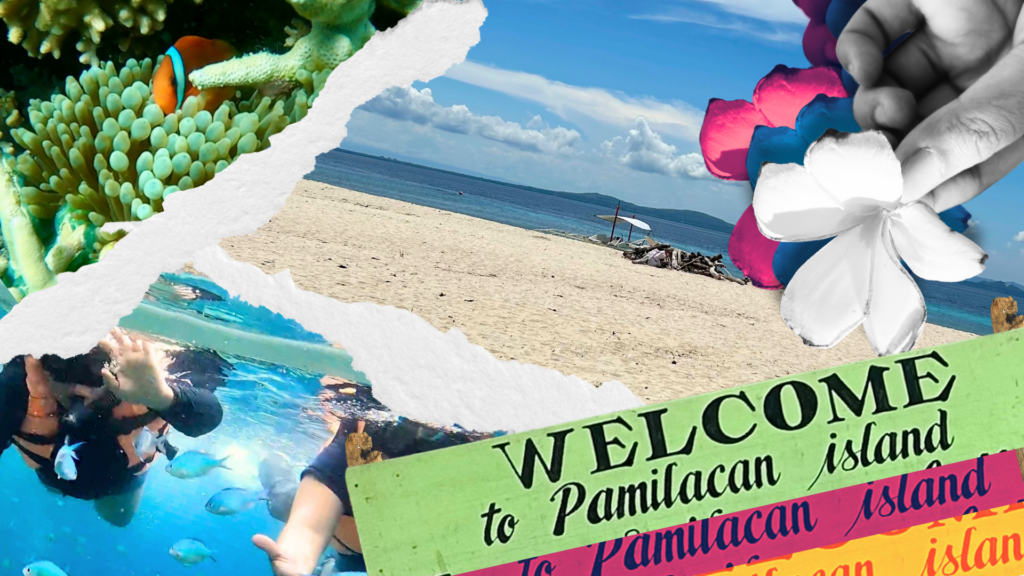
Pamilacan Island is part of the Municipality of Baclayon. It is known for its white sandy shores and crystal clear waters. | GFX by: Christian Gerard Jamora
(Note: This is a first-hand travel experience by the author.)
Who would have thought I could become so mesmerized and attached to an island that I wouldn’t want to leave?
Pamilacan Island in Bohol is one of those rare places where time seems to stand still and invite you to linger for just a few more days, if not forever.
I arrived in Panglao, Bohol, on June 2, carrying my new brown leather backpack, which I had just bought at a discounted price. Initially, I thought I had overpacked, but when I opened the bag, I realized I had forgotten to pack an extra bra. But never mind, I figured I could manage with silicone tape. After all, Panglao is a popular destination for foreigners, and everywhere you look, people are comfortably strolling around in bikinis.
And it didn’t really matter as long as I brought the most important things with me: my black rash guard and long-legged black jeggings for our first-day trip to Pamilacan Island. I still can’t believe I’ve been there; it was my first time.
How to get to Pamilacan Island in Bohol
Pamilacan Island is part of the Municipality of Baclayon, but it can still be accessed from Alona Beach in Panglao.
READ MORE:
2 top tourism sites in Bohol up for rehab
Loboc river cruise in Bohol to implement price increase
Panglao, Bohol among top 10 trending travel destinations for 2024
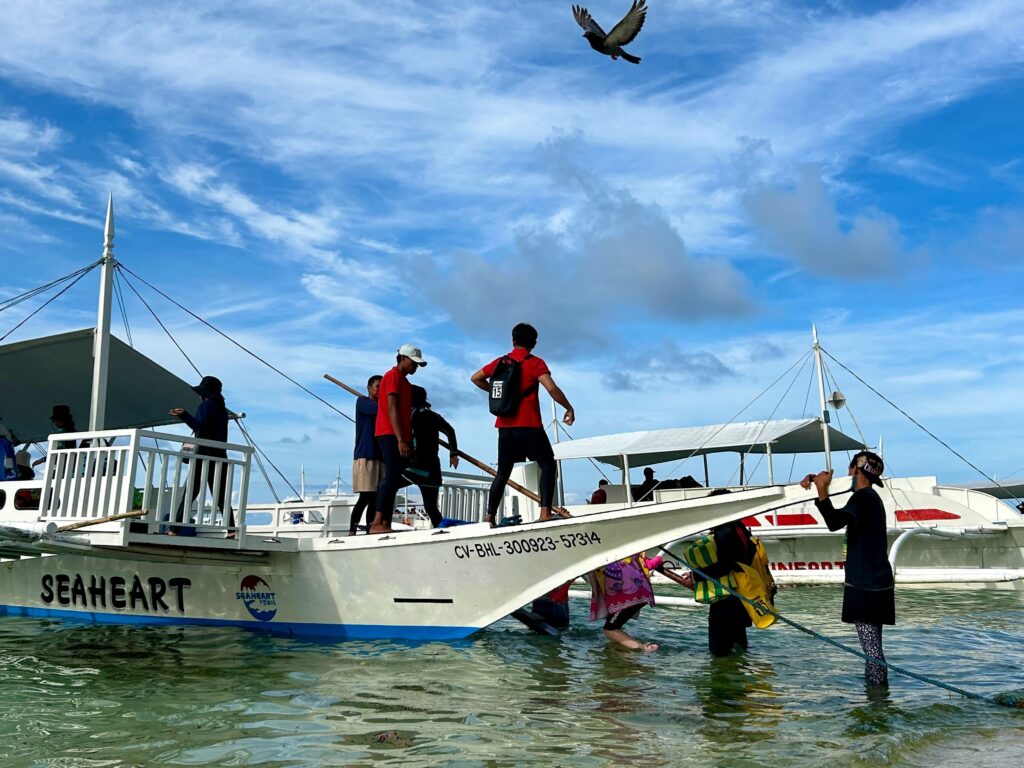
The bangka rate from Alona Beach to Pamilacan Island costs more or less 5,000 pesos depending on its size and engine. | CDN Photo/ Pia Piquero
On the morning of June 3, I was so excited that I overapplied sunblock on my face—at least five times—but that’s okay; at least it helped. I was with my media colleagues. We boarded a bangka (a double outrigger boat). There were about 10 of us, along with three local guides.
Bangka boat rates at Pamilacan Island
In Panglao, the rates for bangka vary. A double-engine boat costs around P5,000, while a single-engine boat goes for about P4,000. The boat’s capacity is determined by the Coast Guard. It also depends on its size. Remember that these prices aren’t set in stone and can fluctuate depending on whom you book with.
From Alona Beach, it takes about an hour and 15 minutes to arrive at the island, though the duration can be longer if the seas are rough. Baclayon port also has access to Pamilacan Island, and it’s actually nearer, taking just 45 minutes to an hour.
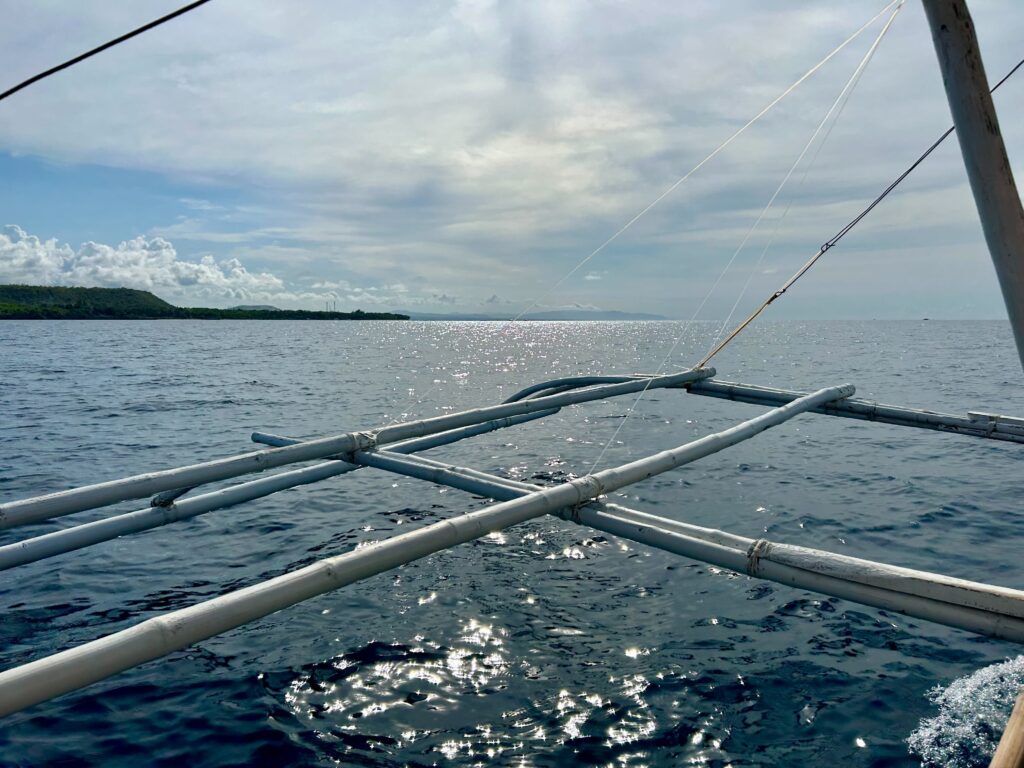
The serene calm seas surrounded Pamilacan Island on the morning of June 3. | CDN Photo/ Pia Piquero
The sea that day was so calm that the boat danced gracefully through the gentle waves. After what felt like an eternity of riding the bangka, we finally arrived at the serene and pristine Pamilacan Island.
The journey, though long, was a beautiful escape in itself.

Pamilacan Island is known for its fine, white sands and crystal-clear waters. | CDN Photo/ Pia Piquero
The sea around Pamilacan Island shimmered with crystal clarity that invited us to dive in and swim endlessly. The water was so transparent that you could see the marine life thriving below, an underwater world begging to be explored. The fine, white sand stretched out like an endless canvas perfect for the colorful tableau of tourists donning their vibrant wetsuits.
The island’s beauty was captivating, rarely found elsewhere. As I descended the wooden stairs from the boat, I felt the cold and calming water envelop my feet. Each step brought a soothing sensation. The gentle lapping of the water against my skin was a refreshing contrast to the warmth of the day, instantly putting me at ease.
Everything just felt relaxing—the serenity of the sea, the soft murmur of waves, and the pristine beauty of the island. It was a moment of pure, unadulterated peace, where all worries seemed to dissolve into the azure expanse.
Room daily rentals at Pamilacan Island start at P1,200
We were warmly greeted by Nemesia Pingkian, the owner of several cottages and rooms available for daily rent. With a welcoming smile, she shared that the rooms are priced at a reasonable P1,200 per person, per night.
For those just visiting for the day, Nemesia explained that the rental fee for the cottages was negotiable, depending on how long you plan to stay and soak in the island. This flexibility makes it easy for day-trippers to enjoy the comforts of the cottages without committing to an overnight stay.
Shortly after our arrival and settling in, we plunged into one of the must-do activities on Pamilacan Island: snorkeling!
Snorkeling is a popular and accessible water activity where you swim on the surface of the water equipped with a diving mask and a snorkel—a tube that allows you to breathe while your face is submerged. It’s an excellent way to explore and observe the marine life and colorful coral reefs just below the surface, without needing extensive training or complex equipment.
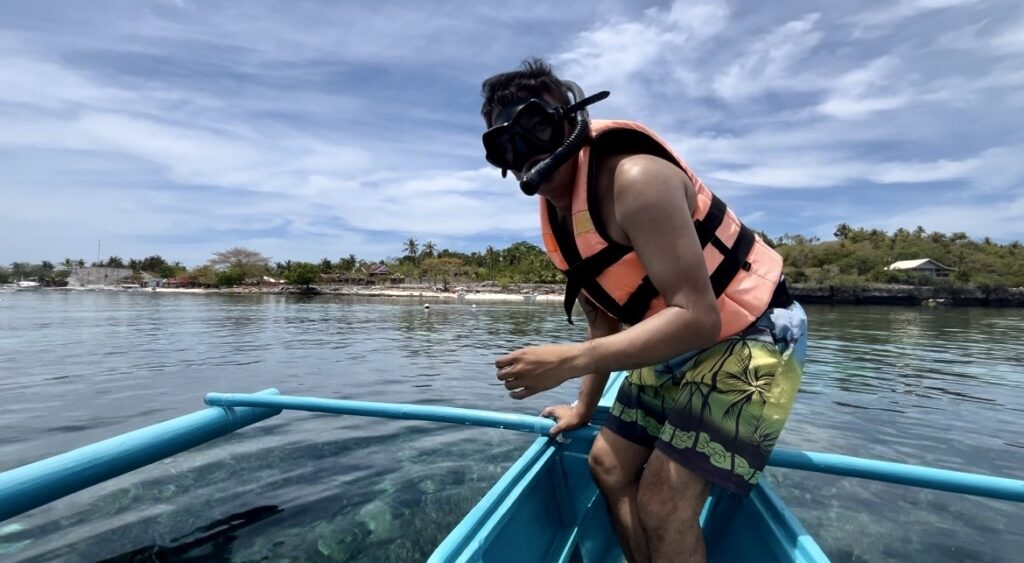
Snorkeling at Pamilacan Island. CDN Photo/ Pia Piquero
Pamilacan Island offers many activities
However, Pamilacan Island offers much more than just snorkeling. Visitors can embark on thrilling dolphin-watching tours, where one can see playful dolphins leaping through the waves. For a touch of relaxation, indulge in soothing massages provided by skilled local therapists, letting the stress melt away as you listen to the gentle sounds of the sea. Adventurous spirits can explore the waters with bangka and pam boating.
For those who prefer to stay on land, hiking around the island reveals breathtaking vistas. The trails lead you through lush landscapes and panoramic views of the ocean and the island’s natural beauty.
Snorkeling at P250 per person, per site
Snorkeling on the island costs P250 per person, per site. You can choose to snorkel at (a) Marine Sanctuary, (b) Turtles, or (c) Coral Gardens. Ate Nemesia recommended Coral Gardens.
We rented snorkeling gear: snorkel masks, snorkel tubes, and snorkel vests. Then we boarded a smaller version of the boat we took from Alona, called a “bigyew.” The Bigyew is a small boat designed to accommodate three individuals, including the local guide who paddles to navigate it. It takes you to the part of the sea where the vibrant corals can be found.
When we arrived at the snorkeling site, the local guide advised us to put on our gear and instructed us on how to get off the bigyew. I was nervous at first, fearing the bigyew might flip, but it didn’t, of course.
When they say that you can truly forget your problems when you go to the sea, I realized it was true. As my body submerged in the cool, crystal-clear water, I felt an immediate sense of relief, as if the weight of my worries was being washed away. The gentle pressure of the water embraced me and provided a soothing, almost therapeutic sensation.
As I began to explore, overwhelming happiness filled me, particularly when I saw the beauty beneath the surface. The underwater world unfolded before my eyes and revealed the vibrant corals, playful schools of fish, and the mesmerizing dance of sea plants swaying with the current.

Photo credit: Internews Earth Journalism Network (2024)
The Coral Garden at Pamilacan Island
It was galactic—a massive kingdom of colorful marine life, vibrant and teeming with energy. The corals came in a myriad of sizes and forms, some with sharp, jagged edges, others resembling delicate flowers in full bloom. At first glance, they seemed like mere rocks, but upon closer inspection, they revealed themselves as bustling communities, home to a multitude of marine creatures.
The hues of the corals reflected a spectrum of colors, changing with the angle of the sun’s rays as they penetrated the clear waters. The scene was a kaleidoscope of blues, pinks, purples, and greens.
It was a beauty you can’t properly define, a visual symphony so stunning that words alone are insufficient to capture its essence. The experience was otherworldly and a reminder of the incredible diversity and wonder hidden beneath the waves.
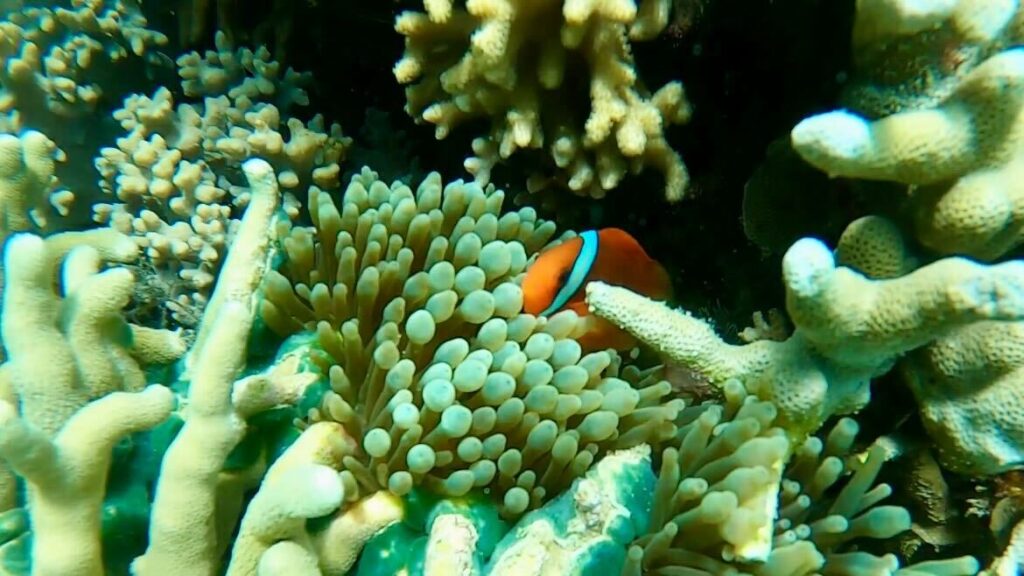
Photo credits: Internews Earth Journalism Network (2024)
I even met Nemo, the clownfish. My childhood heart was satisfied as I watched him dart in and out of his orange home, an anemone, swaying rhythmically with the waves. It was like a scene straight out of the movie. I couldn’t help but wonder where Dory was, half-expecting to see her pop out and join in the underwater dance.
After an hour of snorkeling—P250 is equivalent to an hour—I went back to the bigyew. As much as I wanted to extend my time, I didn’t because I feared being left behind.

Lunch at Pamilacan Island cooked by locals. | Photo by: Queenie Joligon
Back on shore, we were treated to a sumptuous lunch that exceeded all expectations. The spread was a feast for both the eyes and the palate. At the heart of the meal was adobong manok, tender chicken simmered to perfection in a rich, savory sauce infused with garlic, vinegar, and soy.
Beside it, a plate of buttered shrimp glistened, the crustaceans cooked just right, their sweet flesh contrasting beautifully with the rich, creamy butter sauce.
Not to be outdone, a perfectly grilled fish took center stage, its skin crisp and slightly charred, encasing moist, flaky meat that melted in the mouth. The accompaniments included sweet, juicy mangoes that provided a refreshing burst of flavor, and swaki, a local delicacy that offered a unique taste of the sea.
Each dish was freshly prepared, and served with a touch of local love that made the meal even more special.
The best thing about visiting a coastal tourist destination is undoubtedly the chance to indulge in the freshest seafood imaginable. There’s a certain magic in knowing that the fish on your plate was caught just hours before it was served and that every bite of shrimp or swaki brings with it a taste of the ocean’s bounty.
As we bid our farewells to the locals, a heavy pang of nostalgia settled in my heart, knowing that it might be years before I have the opportunity to return.
Pamilacan Island, a magical place
Pamilacan Island is undeniably a gem, an unforgettable escapade, a magical place that captivates the soul. However, behind its stunning facade lie hidden wounds and pressing problems that the residents and the island itself grapple with daily.
Among the challenges is the encroachment of commercial fishers into municipal waters, threatening the marine ecosystem that sustains life around the island. Additionally, a disparity in political leadership between the island and the mainland worsens existing issues that leave the residents vulnerable and their voices often unheard.
In the face of these adversities, the question arises: does Pamilacan Island deserve to be protected at all costs to preserve its marine biodiversity? The answer is clear: protecting Pamilacan Island is crucial not just for its beauty, but also for the people who depend on it for their livelihoods and well-being.
More of these issues will be covered in a special report on Pamilacan Island coming soon.
